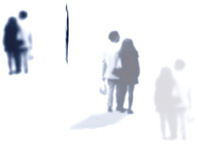
= DISPLACED_PERSONS say NOTHING to NOBODY
© CHRISTIN LAHR, "crossLinks", Marstall, Berlin, 1999, last update 23.05.1999
email:lahr@khm.de
 |
|
[DPsNtN]
german
= DISPLACED_PERSONS say NOTHING to NOBODY
|
|
DISPLACED_PERSONS is a computer-controlled interactive environment linked with
the Internet. Its core is made up by the interfaces and/or overlappings of
physical and virtual spaces, focused on the area of communication between
humans.
Unlike the habitual way, INTERACTION in this work is produced not by action but by DOING_NOTHING, by NON-ACTION. |
| BACKGROUNDS |
|
Displaced persons have influenced and characterized every society and social structures so far -
complying with these actual developments they are coming more and more to the fore as
a global phenomenon. The splitting of world power into small states as well as the opposite
efforts for a common Europe, streams of refugees and the increase of worldwide tourism -
to give only a few examples - evokes displaced persons in an increasing degree - "SITE_LESS PEOPLE",
who are starting to fail with the question of identification by necessity.
Intensified by the process of worldwide globalisation and net structures, based on the so-called "New Technologies" we are standing in front of a tremendous process of transformation where words like "HERE" and "THERE", "PRESENCE" and "ABSENCE", "VICINITY" and "DISTANCE" needs to be defined in the sense of a new way of meanings. The definition of "SPACE" between "NOWHERE" and "SOMEWHERE" has started to become completely relative. The question of beeing located inbetween these interspaces needs to be unveiled. At the moment we already live a part of our lifes as "VIRTUAL EXISTENCES" or "DATA BODIES" also in immaterial data spaces. Virtual means something caused by virtue or by possibility; "EXISTANCE"; "LIFE", "BEING_THERE"; "REALITY", "TRUTH" - a paradox of a "POSSIBLE IMPOSSIBILITY" - maybe a indication for social development in future - for sure the beginning of staggering between material and immaterial, between "APPEARANCE" and "BEING". The body as a part of "physical reality" remains "outside". The number of displaced persons is evolving as a reaction, their experiences result from tumbling between these two worlds (physical and virtual). To what extend the virtual identity will mark the body, if it isn´t a latent part of the own identity in any case, still remains uncertain.
The artwork DISPLACED_PERSONS was a result of a extensive research of MUDs and MOOS - a investigation
of immaterial areas in the internet based on language - virtual environments which are changing in real
time solely engendered and kept alive by the IMAGINATIONS and ILLUSIONS of the users. One of my basic
interests was the transformation of a new development in culture of language - between spoken and written
language, which I would call "SPOKEN WRITING" or "WRITTEN SPEAKING".
|
|
CHARACTER: DISPLACED_PERSONS
Usage: connect <existing-player-name> <password> DISPLACED_PERSONS is owned by DISPLACED_PERSONS Aliases: [DP], [sNtN] gender: not set You see a person who/which is not set in gender. It wonders where it is going, it wonders where it is. It is curious about the differences between virtual and real life. It is a person of indefinite height and it is dressed rather non-descriptly, but it has the ideal measures and a perfect outfit in any way. The most exciting thing however is its huge variety of different identities. It could be EVERYBODY. It is awake and looks alert. Obvious Verbs: - wh*isper <anything> to DISPLACED_PERSONS - examine DISPLACED_PERSONS - look DISPLACED_PERSONS - give <anything> to DISPLACED_PERSONS - gag DISPLACED_PERSONS - dea*fen DISPLACED_PERSONS - blind*fold/blind DISPLACED_PERSONS - fol*low DISPLACED_PERSONS carrying: nothing but its IMAGINATIONs |
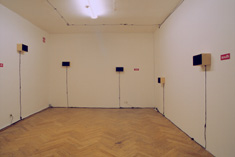
|
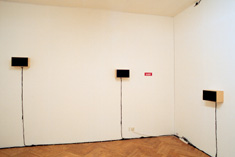
|
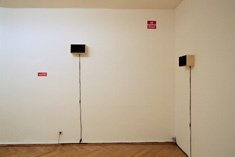
|
In an empty room there are 8 loudspeakers
as well as 8 red plastic signs with the following words engraved: north,
south, east, west, up, down, in, out. These words, which we normally use to
navigate through physical space, are at the same time the main commands for
navigating within virtual spaces.
As long as there are no visitors in the room, the loudspeakers emit a computer-generated multivocal POLYLOGUE of different synthetic prototypes in which questions relating, among other things, to PRESENCE and ABSENCE, TRUTH and LIES, GENDER, APPEARANCE, IDENTITY and NAVIGATION are raised. These texts are based on a several-months-long computing task in "LambdaMOO", and the experience gathered there with communication behaviour in virtual spaces where, reduced to 256 characters (ASCII code), emotions and lacking possibilities of body-lingual expression are compensated for by forms such as emoticons or acronyms. |
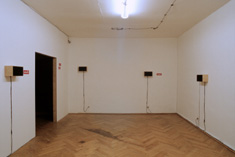
|
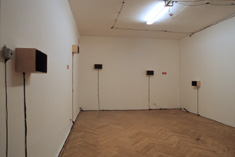
|
| The instant somebody enters the room the voices abruptly break off and the sudden silence makes it clear that this entry is seen as an "intrusion". The POLYLOGUE of synthetic voices only resumes when everyone has left the room, or found in it a place where they remain motionless. Solely the ABSOLUTE IMMOBILITY of all the people in the room is the trigger for the sound installation. This demonstrates to the visitors a state of mutual DEPENDENCY (internetworking), which imparts itself in different guises over and over again. |
 |
 |
 |
 |
 |
 |
 |
 |
 |
 |
 |
 |
 |
 |
 |
 |
Every individual can influence what takes place, the result is the
COMMON EXPRESSION of all participants. In this moment of joint KEEPING_QUIET
the visitors in the room "melt" into LIVING SCULPTURES and thus become
EXHIBITS themselves, giving outsiders the impression of "LIVING FOSSILS". If a
motionless state fails to occur for a longer period of time, the following
command booms from the loudspeaker:

"DEAR VISITOR! DON´T MOVE YOUR BODY, OR THE COMMUNICATION WILL NOT GO ON" |
 |
 |
 |
 |
 |
 |
 |
 |
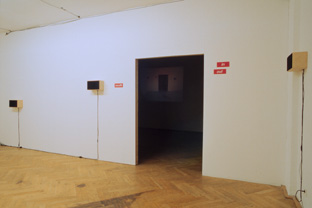 |
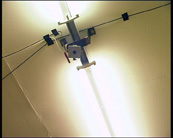 |
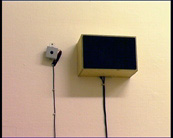 |
|
cam03, normal camera lense
able to be turned around by motor |
cam04, normal camera lense |
| It is possible to observe these goings-on from a remote standpoint via the World-Wide-Web. To this end, 5 surveillance cameras (4 inside, one outside) distributed around the environment continuously supply live video images from different camera angles. These streaming videos can be called up at the navigation page of the Web site DISPLACED_PERSONS, from where Web users can control the cameras and switch between the different angles. One of the cameras is motorized and can be turned around about 360° with the aid of certain navigation tools. Depending on the current situation at a given time, Web users will be confronted with either an empty room or "LIVING FOSSILS". In this way the visitors become EXHIBITS themselves. |
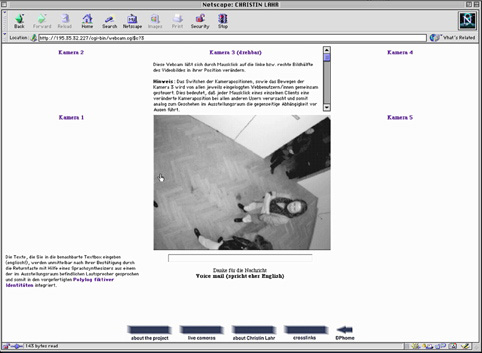 |
| In analogy to the interactive environment in the exhibition room also the livecams are collectively navigated by all the users online. In this way every individual can influence the streamed video signal each time. Changing a certain camera position by an user causes the interchange of the video image at all the other users. The fewer the users agree to each others decision the faster is the switching between the different camera angles. The case of the most disturbed communication at least induces a rustle which is getting part of the white background. Only if the users are calming down again they are able to go on watching and observing what happens inside of the exhibition room. |
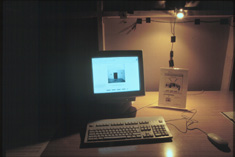 |
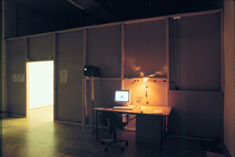 |
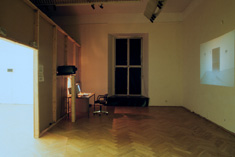 |
Outside of the Environment there is also a computer with constant access to the
Webpage DISPLACED_PERSONS.
In this way the visitors are able to empathize and control the possibilities of interactivity via internet immediately. One of the livecams is regulated in a way to catch the visitor sitting in front of the computer with the video projection in his back. By selecting that camera the visitor of the exhibition looks at him/herself, the user on the net at the visitor or an empty chair. |
 |
 |
 |
 |
 |
 |
 |
 |
 |
 |
 |
 |
| The images of the selected surveillance camera are immediately projected via a video projector (connected with the interface) within the exhibition space. The "CUTS" of the projected video are resulting directly from the clicking behaviour of the users - a documentation of their ACTIVITIES and PROCESS OF COMMUNICATION. |
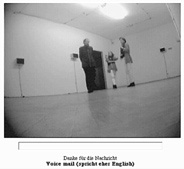 |
Beside of the selectable livecams the Webpage DISPLACED_PERSONS further contains a text-entry-window. With the help of this window the external user is able to influence and to extend the synthetic and prepared POLYLOGUE inside of the exhibition room. The text typed in by the users who are able to react immediately to what happens inside of the room were spoken by a synthesizer out of one of the loudspeakers and directly integrated in the prepared POLYLOGUE of FICTIVE IDENTITIES. |